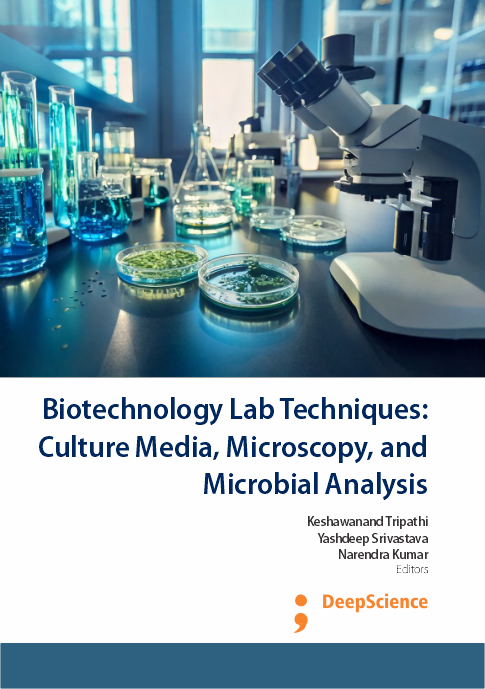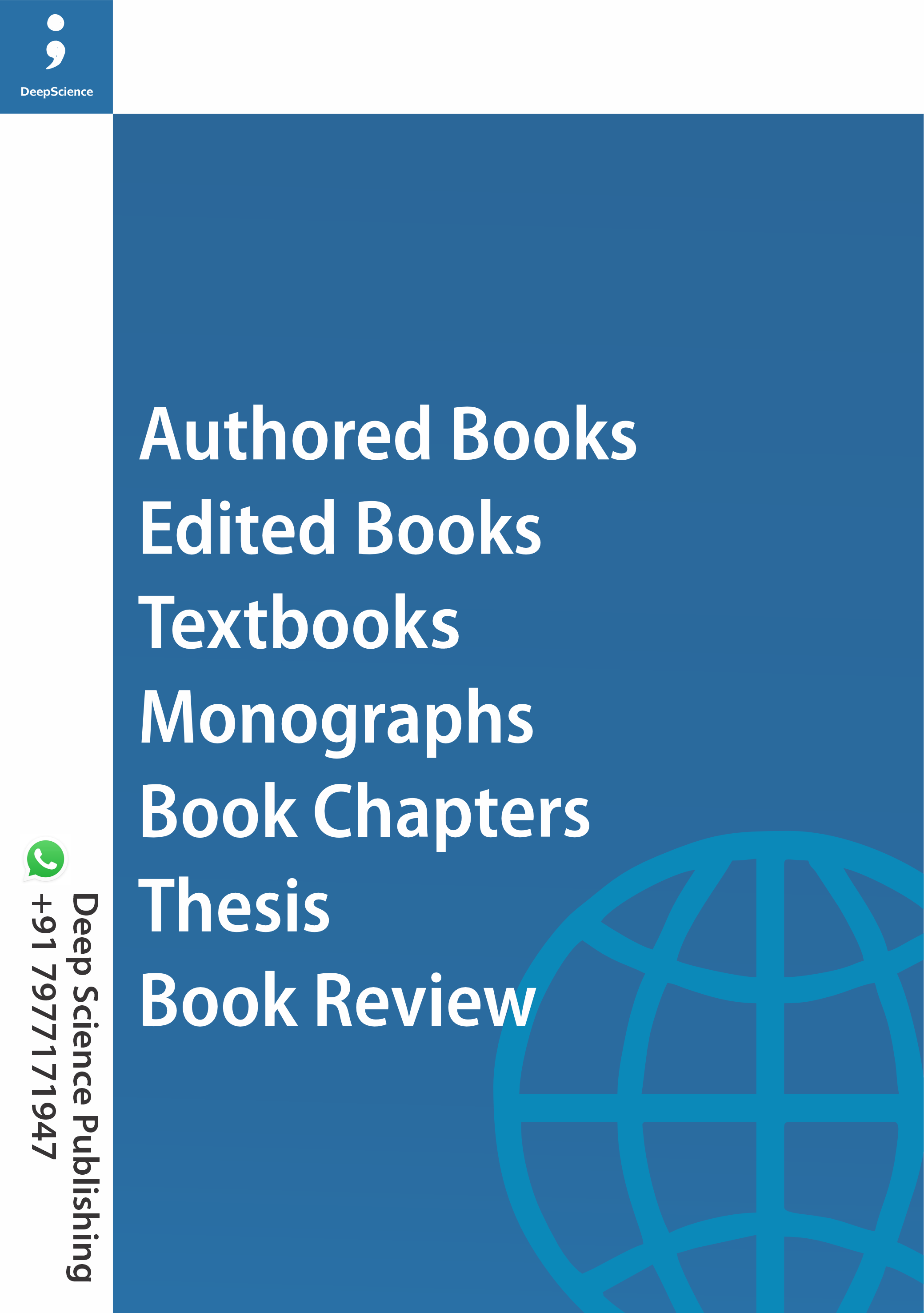Biotechnology Lab Techniques: Culture Media, Microscopy, and Microbial Analysis
Keywords:
Sterilization, Microbiology, Plant tissue culture, Laboratory safety, Microbial isolation, Autoclave sterilization, MicroscopySynopsis
Welcome to the "Biotechnology Lab Techniques: Culture Media, Microscopy, and Microbial Analysis”. This comprehensive manual is designed to be an essential companion for students, researchers, and professionals in the field of life sciences. Whether you are just starting your journey into laboratory practices or looking to deepen your understanding of advanced techniques, this handbook provides clear and practical guidance.
The world of life sciences is built upon a foundation of rigorous laboratory work, where precision and technique are paramount. This handbook begins with an introduction to basic laboratory practices, ensuring that readers develop a strong grasp of fundamental skills. From handling laboratory equipment to mastering techniques like smear preparation and staining of microorganisms, each chapter is structured to build upon the last, offering a progressive learning experience.
Central to this handbook are detailed sections on laboratory equipment and tools, essential for conducting experiments effectively. Whether you are operating a compound microscope, utilizing an autoclave for sterilization, or conducting experiments with UV-Vis spectrophotometers, this handbook provides comprehensive insights into their functions and applications.
Preparing media for cultivating microorganisms is a crucial skill covered extensively in this handbook. From nutrient broths to specialized agar types like McConkey and Chocolate agar, each recipe is meticulously detailed to ensure successful growth and isolation of pure microbial colonies. Techniques such as spread plating and streak plating are explained step-by-step, empowering researchers to isolate and study microbes with precision.
Beyond basic techniques, this handbook delves into advanced topics such as the impact of environmental factors like UV radiation and pH on microbial growth. Techniques for assessing cell viability and methods for evaluating antibacterial efficacy of natural products are also explored in detail, reflecting the handbook's commitment to practical relevance in contemporary research.
Additionally, this handbook encompasses techniques in molecular biology and biochemistry, from isolating nucleic acids and proteins to conducting gel electrophoresis and protein estimation assays. These techniques are pivotal for advancing research in genetics, biotechnology, and pharmaceutical sciences.
Furthermore, the handbook extends its scope to include botanical and environmental sciences, featuring methods for estimating chlorophyll content, investigating organogenesis in plants, and assessing biochemical oxygen demand in water samples. Each chapter is authored by experts in their respective fields, ensuring that the content is not only informative but also reliable and up-to-date with current scientific practices.
In conclusion, " Biotechnology Lab Techniques: Culture Media, Microscopy, and Microbial Analysis " is more than just a reference guide; it is a practical companion that equips readers with the knowledge and skills necessary to excel in their scientific endeavors. Whether used in educational settings or research laboratories, this handbook serves as an indispensable tool for navigating the complexities of life sciences.
Chapters
-
Fundamentals of laboratory practices: Principles, techniques, and safety protocols
-
Essential laboratory equipment and tools: Functions, handling, and applications
-
Composition, optimization, and preparation of culture media for microbiological and biotechnological applications
-
Techniques for isolation of pure microbial colonies: Principles, methods, and applications
-
Standardized techniques for microbial smear preparation: Principles, staining protocols, and microscopic evaluation
-
Staining techniques for microorganisms: Principles, methods, and diagnostic applications
-
Effects of ultraviolet (UV) radiation on microbial growth: Mechanisms, responses, and applications
-
Influence of pH on microbial growth: Mechanisms, adaptations, and industrial implications
-
Trypan blue dye exclusion assay: Principles, protocols, and applications in cell viability assessment
-
Evans blue dye exclusion assay: Mechanisms, protocols, and applications in cell viability analysis
-
Paraffin block preparation and histological staining: Techniques for tissue structure analysis
-
Paraffin preservation of microbial cultures: Techniques, mechanisms, and long-term storage applications
-
Lyophilization of microbial cultures: Principles, techniques, and applications in long-term preservation
-
Assessment of antibacterial efficacy of selected natural products: Methods, mechanisms, and applications
-
Quantitative analysis of bacterial growth: Methods for measuring growth curves and kinetic parameters
-
Enumeration of soil microbiota: Calculation of colony forming units (CFU) for microbial quantification
-
Replica plating technique for identifying E. Coli auxotrophic mutants: Principles, methods, and application
-
Measurement of water potential: Comparative analysis of three distinct methods in biological systems
-
Experimental demonstration of transpiration pull: Mercury method for measuring xylem water transport
-
Estimation of biochemical oxygen demand (BOD): Principles, methodology, and water quality assessment
-
Quantitative estimation of dissolved oxygen (DO) in water samples: Principles, methods, and environmental significance
-
Isolation of bacterial chromosomal DNA: principles, techniques, and analytical applications
-
Extraction and purification of plasmid DNA from bacteria: Techniques and applications in molecular biology
-
CTAB-Based extraction of total plant genomic DNA: Principles, protocols, and applications
-
Trizol-based RNA extraction: Principles, protocol, and applications in molecular biology
-
Synthesis of complementary DNA (C-DNA): Principles, methodology, and applications in gene expression studies
-
Agarose gel electrophoresis of DNA: Principles, protocols, and applications in molecular analysis
-
Isolation and purification of recombinant proteins: Principles, techniques, and biotechnological applications
-
SDS-PAGE Analysis of proteins: Principles, methodology, and applications in proteomics
-
Experimental validation of lambert-beer’s law: Principles, spectrophotometric analysis, and applications
-
Quantitative protein estimation using the Bradford assay: Principles, protocols, and applications
-
Biuret assay for protein estimation: Principles, methodology, and analytical applications
-
Lowry method for protein quantification: Principles, protocols, and applications in biochemical analysis
-
Spectrophotometric estimation of phytosterols: Principles, methodology, and analytical applications
-
Quantification of leaf chlorophyll content: Spectrophotometric estimation and physiological implications
-
Investigation of organogenesis in bacopa monnieri: Mechanisms, tissue culture techniques, and developmental insights
References
Wilson, K., & Walker, J. (2010). Principles and Techniques of Biochemistry and Molecular Biology (7th ed.). Cambridge University Press.
https://doi.org/10.1017/CBO9780511841477
Boyer, R.F. (2006). Modern Experimental Biochemistry (3rd ed.). Pearson.
Skoog, D.A., Holler, F.J., & Crouch, S.R. (2017). Principles of Instrumental Analysis (7th ed.). Cengage Learning.
Plummer, D.T. (1988). An Introduction to Practical Biochemistry (3rd ed.). McGraw-Hill.
Sundaramoorthy, M. (2016). Laboratory Manual in Biochemistry. PHI Learning Pvt. Ltd. Rao, S.R., & Ghosh, T. (2011). Good laboratory practices in biological research. Journal of Scientific Research, 55(2), 112-118.
Tripathi, K., Sharma, N. K., Rai, V., & Rai, A. K. (2013). Low cellular P-quota and poor metabolic adaptations of the freshwater cyanobacterium Anabaena fertilissima Rao during Pi-limitation. Antonie van Leeuwenhoek, 103, 277-291.
https://doi.org/10.1007/s10482-012-9808-x
Tripathi, K., Sharma, N. K., Kageyama, H., Takabe, T., & Rai, A. K. (2013). Physiological, biochemical and molecular responses of the halophilic cyanobacterium Aphanothece halophytica to Pi-deficiency. European Journal of Phycology, 48(4), 461-473
https://doi.org/10.1080/09670262.2013.859303
Rao, S.R., & Ghosh, T. (2011). Good laboratory practices in biological research. Journal of Scientific Research, 55(2), 112-118.
Hughes, G.J., & Smith, J.D. (2010). Basic laboratory skills in life sciences: An overview of essential techniques. Biotechnology Advances, 28(3), 325-337.
Myers, J.R. (2015). Best practices for laboratory safety and hygiene in microbiology. Applied and Environmental Microbiology, 81(19), 6475-6483.
Martins, J.M., & Silva, L.R. (2014). Laboratory organization and standard operating procedures for beginners. Nature Protocols, 9(7), 1113-1121.
Rittman, B.E., & McCarty, P.L. (2012). Laboratory methods for biological research in environmental sciences. Environmental Science & Technology, 46(12), 6545-6552
Tiwari, P., Srivastava, Y., & Kumar, V. (2022). Antimicrobial peptides as effective agents against drug-resistant pathogens. Antimicrobial Resistance: Underlying Mechanisms and Therapeutic Approaches, 289-322.
https://doi.org/10.1007/978-981-16-3120-7_11
Thagela, P., Yadav, R. K., Tripathi, K., Singh, P. K., Ahmad, A., Dahuja, A., & Abraham, G. (2018). Salinity induced changes in the chloroplast proteome of the aquatic pteridophyte Azolla microphylla. Symbiosis, 75, 61-67.
https://doi.org/10.1007/s13199-017-0521-4
Tripathi, K., Sharma, N. K., Rai, V., & Rai, A. K. (2013). Low cellular P-quota and poor metabolic adaptations of the freshwater cyanobacterium Anabaena fertilissima Rao during Pi-limitation. Antonie van Leeuwenhoek, 103, 277-291.
https://doi.org/10.1007/s10482-012-9808-x
Tripathi, K., Sharma, N. K., Kageyama, H., Takabe, T., & Rai, A. K. (2013). Physiological, biochemical and molecular responses of the halophilic cyanobacterium Aphanothece halophytica to Pi-deficiency. European Journal of Phycology, 48(4), 461-473.
https://doi.org/10.1080/09670262.2013.859303
Tripathi, K., Kumar, N., & Abraham, G. (Eds.). (2018). The role of photosynthetic microbes in agriculture and industry. Nova Science Publisher's, USA
Bergey, D. H., & Holt, J. G. (2000). Bergey's Manual of Determinative Bacteriology (9th ed.). Williams & Wilkins.
Reed, R. H., & Chudek, J. A. (1993). Influence of growth media on bacterial adaptation. Applied and Environmental Microbiology, 59(2), 300-305.
Allen, M. B., & Arnon, D. I. (1955). Studies on nitrogen-fixing blue-green algae. Plant Physiology, 30(4), 366-372. https://doi.org/10.1104/pp.30.4.366
Hoagland, D. R., & Arnon, D. I. (1950). The water-culture method for growing plants without soil. California Agricultural Experiment Station Circular, 347, 1-32.
Tripathi, K., Sharma, N. K., Rai, V., & Rai, A. K. (2013). Low cellular P-quota and poor metabolic adaptations of the freshwater cyanobacterium Anabaena fertilissima Rao during Pi-limitation. Antonie van Leeuwenhoek, 103, 277-291.
https://doi.org/10.1007/s10482-012-9808-x
Tripathi, K., Kumar, N., & Abraham, G. (Eds.). (2018). The role of photosynthetic microbes in agriculture and industry. Nova Science Publisher. USA,
Yadav, R. K., Thagela, P., Tripathi, K., & Abraham, G. (2016). Physiological and proteomic analysis of salinity tolerance of the halotolerant cyanobacterium Anabaena sp. World Journal of Microbiology and Biotechnology, 32, 1-11.
https://doi.org/10.1007/s11274-016-2098-0
Reddy, Y. P., Yadav, R. K., Tripathi, K., & Abraham, G. (2019). Isolation and characterization of high temperature tolerant mutant from the cyanobacterium Anabaena doliolum. Journal of basic microbiology, 59(3), 314-322.
https://doi.org/10.1002/jobm.201800447
Yadav, R. K., Tripathi, K., Varghese, E., & Abraham, G. (2021). Physiological and proteomic studies of the cyanobacterium Anabaena sp. acclimated to desiccation stress. Current Microbiology, 78(6), 2429-2439.
https://doi.org/10.1007/s00284-021-02504-x
Stanier, R. Y., Ingraham, J. L., Wheelis, M. L., & Painter, P. R. (1986). The microbial world (5th ed.). Prentice Hall.
Monod, J. (1949). The growth of bacterial cultures. Annual Review of Microbiology, 3(1), 371-394.
https://doi.org/10.1146/annurev.mi.03.100149.002103
Atlas, R. M. (2010). Handbook of microbiological media (4th ed.). CRC Press.
https://doi.org/10.1201/EBK1439804063
Tripathi, K., Kumar, N., & Abraham, G. (Eds.). (2018). The role of photosynthetic microbes in agriculture and industry. Nova Science Publishers.
Yadav, R. K., Chatrath, A., Tripathi, K., Gerard, M., Ahmad, A., Mishra, V., & Abraham, G. (2021). Salinity tolerance mechanism in the aquatic nitrogen-fixing pteridophyte Azolla: A review. Symbiosis, 83, 129-142.
https://doi.org/10.1007/s13199-020-00736-2
Reddy, Y. P., Yadav, R. K., Tripathi, K., & Abraham, G. (2019). Isolation and characterization of high temperature tolerant mutant from the cyanobacterium Anabaena doliolum. Journal of basic microbiology, 59(3), 314-322.
https://doi.org/10.1002/jobm.201800447
Yadav, R. K., Thagela, P., Tripathi, K., & Abraham, G. (2016). Physiological and proteomic analysis of salinity tolerance of the halotolerant cyanobacterium Anabaena sp. World Journal of Microbiology and Biotechnology, 32, 1-11.
https://doi.org/10.1007/s11274-016-2098-0
Tripathi, K., Sharma, N. K., Kageyama, H., Takabe, T., & Rai, A. K. (2013). Physiological, biochemical and molecular responses of the halophilic cyanobacterium Aphanothece halophytica to Pi-deficiency. European Journal of Phycology, 48(4), 461-473.
https://doi.org/10.1080/09670262.2013.859303
Tripathi, K., Sharma, N. K., Rai, V., & Rai, A. K. (2013). Low cellular P-quota and poor metabolic adaptations of the freshwater cyanobacterium Anabaena fertilissima Rao during Pi-limitation. Antonie van Leeuwenhoek, 103, 277-291.
https://doi.org/10.1007/s10482-012-9808-x
Taiz, L., Zeiger, E., Møller, I. M., & Murphy, A. (2015). Plant physiology and development (6th ed.). Sinauer Associates.
Salisbury, F. B., & Ross, C. W. (1992). Plant physiology (4th ed.). Wadsworth Publishing.
Westgate, M. E., & Boyer, J. S. (1985). Osmotic adjustment and the inhibition of leaf, root, stem, and silk growth at low water potentials in maize. Plant Physiology, 78(3), 828-834.
Yadav, R. K., Ramteke, P. W., Tripathi, K., Varghese, E., & Abraham, G. (2023). Salinity-induced alterations in the growth and cellular ion content of Azolla caroliniana and Azolla microphylla. Journal of Plant Growth Regulation, 42(2), 867-876.
https://doi.org/10.1007/s00344-022-10594-5
Sawyer, C.N., McCarty, P.L., & Parkin, G.F. (2003). Chemistry for Environmental Engineering and Science (5th ed.). McGraw-Hill.
Metcalf & Eddy. (2013). Wastewater Engineering: Treatment and Resource Recovery (5th ed.). McGraw-Hill.
Tripathi, K., Kumar, N., & Abraham, G. (Eds.). (2018). The role of photosynthetic microbes in agriculture and industry. Nova Science Publishers.
Tripathi, K., Sharma, N. K., Rai, V., & Rai, A. K. (2013). Low cellular P-quota and poor metabolic adaptations of the freshwater cyanobacterium Anabaena fertilissima Rao during Pi-limitation. Antonie van Leeuwenhoek, 103, 277-291.
https://doi.org/10.1007/s10482-012-9808-x
Xu, J., Jin, G., Mo, Y., Tang, H., & Li, L. (2020). Assessing anthropogenic impacts on chemical and biochemical oxygen demand in different spatial scales with bayesian networks. Water, 12(1), 246.
https://doi.org/10.3390/w12010246
Yadav, R. K., Ramteke, P. W., Tripathi, K., Varghese, E., & Abraham, G. (2023). Salinity-induced alterations in the growth and cellular ion content of Azolla caroliniana and Azolla microphylla. Journal of Plant Growth Regulation, 42(2), 867-876.
https://doi.org/10.1007/s00344-022-10594-5
Doyle, J.J., & Doyle, J.L. (1990). A rapid total DNA preparation procedure for fresh plant tissue. Focus, 12(1), 13-15.
Sambrook, J., & Russell, D.W. (2001). Molecular Cloning: A Laboratory Manual (3rd ed.). Cold Spring Harbor Laboratory Press.
Brown, T.A. (2010). Gene Cloning and DNA Analysis: An Introduction (6th ed.). Wiley-Blackwell.
Wilson, K., & Walker, J. (2010). Principles and Techniques of Biochemistry and Molecular Biology (7th ed.). Cambridge University Press.
https://doi.org/10.1017/CBO9780511841477
Reddy, Y. P., Yadav, R. K., Tripathi, K., & Abraham, G. (2019). Isolation and characterization of high temperature tolerant mutant from the cyanobacterium Anabaena doliolum. Journal of basic microbiology, 59(3), 314-322.
https://doi.org/10.1002/jobm.201800447
Tripathi, K., Kumar, N., Singh, M., & Singh, R. K. (2021). Fungal Siderophore: Biosynthesis, Transport, Regulation, and Potential. Rhizosphere Microbes: Soil and Plant Functions, 23, 387.
https://doi.org/10.1007/978-981-15-9154-9_15
Srivastava, Y., Tripathi, S., Mishra, B., & Sangwan, N. S. (2022). Cloning and homologous characterization of geranylgeranyl pyrophosphate synthase (GGPPS) from Withania somnifera revealed alterations in metabolic flux towards gibberellic acid biosynthesis. Planta, 256(1), 4.














